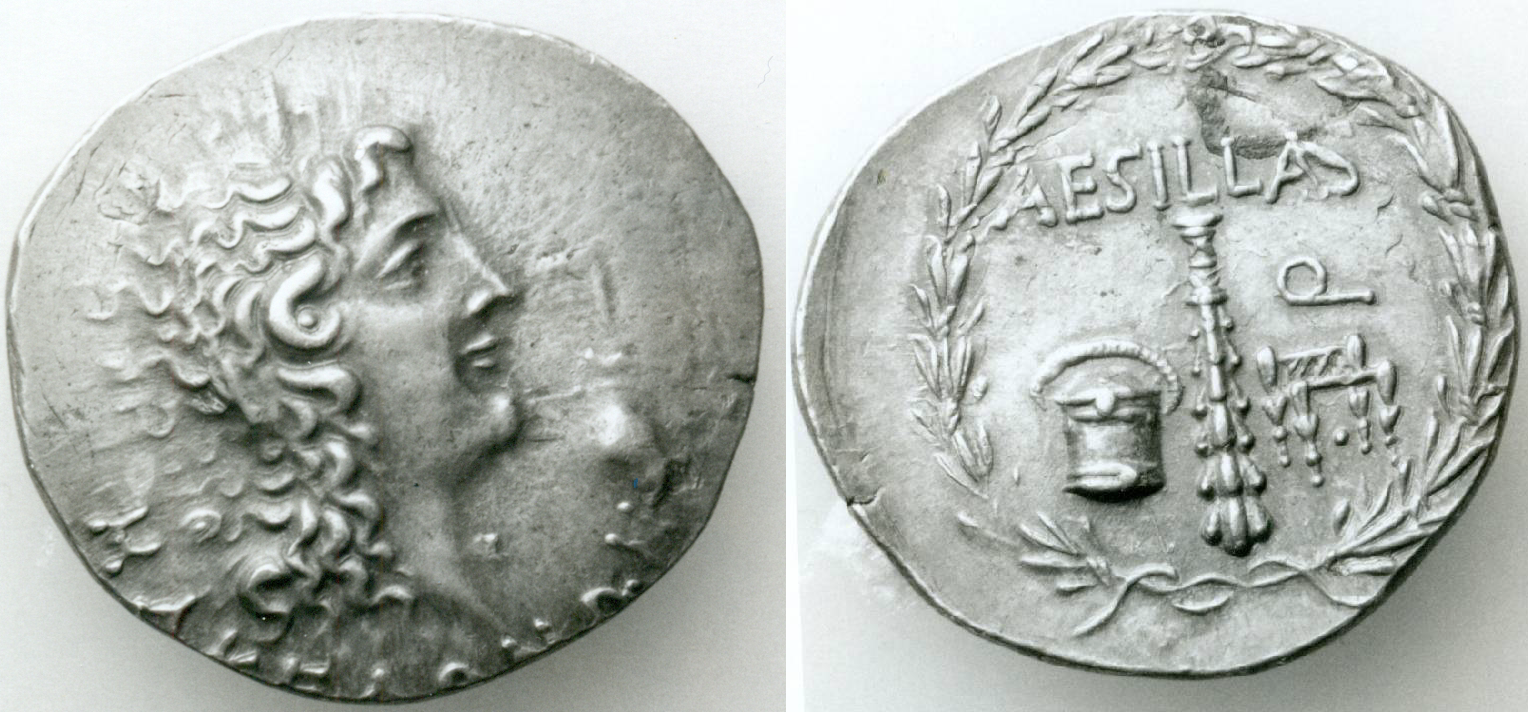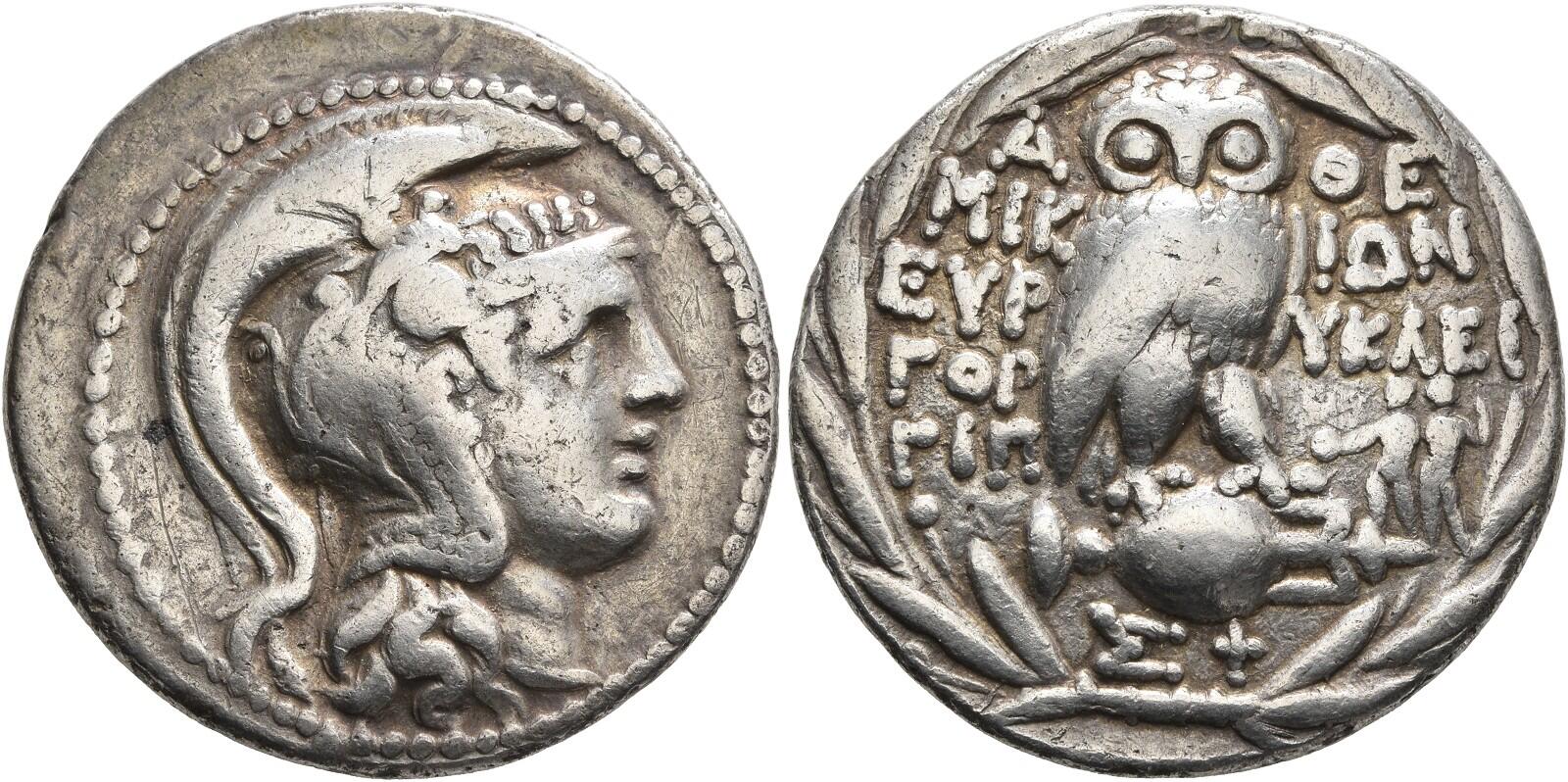3698 - Thessalonica (Aesillas) (tetradrachm Alexander/club) over Athens (Athena/owl) (CNG, 20, March 1992, 62): Difference between revisions
From SILVER
m (Callatay moved page SO 890 - Thessalonica over Athens to 890 - Thessalonica (Aesillas) over Athens (CNG, March 1992, 62)) |
No edit summary |
||
| Line 1: | Line 1: | ||
{{Overstrike | {{Overstrike | ||
|Image overstriking coin=SO 890 - Thessalonica over Athens.png | |Image overstriking coin=SO 890 - Thessalonica over Athens.png | ||
|Sale=Coin Galleries, FPL | |Image overstruck variety=Athens Mikion Euryklei.jpg | ||
|Sale=Coin Galleries, FPL, 13 Nov. 1991, lot 83 = Classical Numismatic Auction, 20, March 1992, lot 62 | |||
|Obverse legend=MAKEΔΟΝΩΝ | |Obverse legend=MAKEΔΟΝΩΝ | ||
|Obverse legend language=Greek | |Obverse legend language=Greek | ||
Revision as of 15:46, 24 May 2023
95 BCE - 70 BCEMAKEΔΟΝΩΝ | AESILLAS Q
Location/history
| Sale(s)Sale(s) ᵖ: | Coin Galleries, FPL, 13 Nov. 1991, lot 83 = Classical Numismatic Auction, 20, March 1992, lot 62 | |
Overstriking coin
Description
| ObverseInscription or printing placed on the obverse.: | MAKEΔΟΝΩΝ (Greek) Head of Alexander the Great right. Behind head, Θ. | ReverseInscription or printing placed on the reverse.: | AESILLAS Q (Latin) Fiscus, club and sella curulis. All within laurel wreath. |
Mint and issuing power
| MintIdentifies the place of manufacture or issue of a numismatic object.: | Thessalonica | Ancient regionAncient region. | Macedon | Modern countryModern country: Greece | AuthorityIdentifies the issuing power. The authority can be "pretended" when the name or the portrait of X is on the coin but he/she was not the issuing power. It can also be "uncertain" when there is no mention of X on the coin but he/she was the issuing power according to the historical sources: | Aesillas (quaestor in the Roman province of Macedonia in c. 90 BC), Roman Republic |
Chronology
| FromIdentifies the initial date in a range assigned in a numismatic context. 95 BCE toIdentifies the final date in a range assigned in a numismatic context.. 70 BCE | hellenistic periodTime period of the numismatic object. |
Physical description
| MetalThe physical material (usually metal) from which an object is made.: Silver |
WeightWeight of the numismatic object (in grams). in grams: 16.6216.62 g <br />16,620 mg <br /> | DenominationTerm indicating the value of a numismatic object. Examples: tetradrachm, chalkous, denarius.: tetradrachm |
|
| StandardStandard.: Attic (reduced) | |||
References
| Coin referenceReference of the Coin: | Coin series referenceReference to coin series study: | Bauslaugh 20001Bauslaugh 2000, Groups I-III, V-VI and VIII (dies O12C-R68), HGC 3.12HGC 3.1, n° 1110 |
Overstruck type
Description
| ObverseInscription or printing placed on the obverse.: | Head of Athena. | ReverseInscription or printing placed on the reverse.: | Owl on amphora. |
Mint and issuing power
| MintIdentifies the place of manufacture or issue of a numismatic object. ᵖ: | Athens | Ancient regionAncient region. ᵖ | Attica | Modern countryModern country: Greece | AuthorityIdentifies the authority in whose name (explicitly or implicitly) a numismatic object was issued. ᵖ: |
Chronology
| FromIdentifies the initial date in a range assigned in a numismatic context. toIdentifies the final date in a range assigned in a numismatic context.. | periodTime period of the numismatic object. |
Physical description
| DenominationTerm indicating the value of a numismatic object. Examples: tetradrachm, chalkous, denarius. ᵖ: | tetradrachm |
References
| Coin type referenceReference to coin series study ᵖ: |
Additional data
| Frequency of overstrikesFrequency of overstrikes: | Level of confidenceLevel of confidence of the identification: | ||
| RemarksRemarks: | |||

